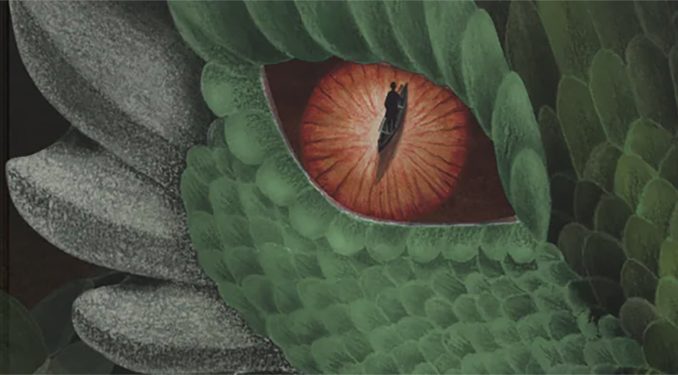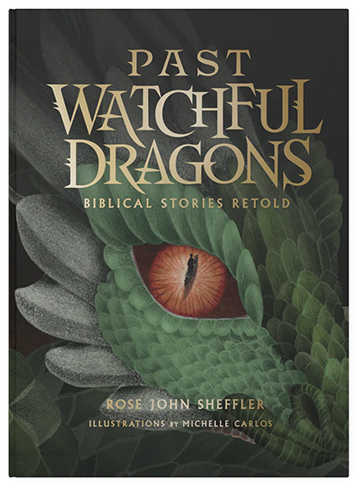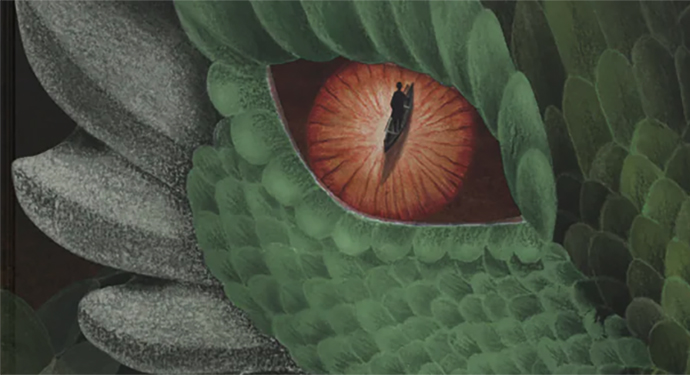
Reflecting upon the post-Christian West’s bias against Christianity, G. K. Chesterton once suggested that his modern-minded countrymen regard the Twelve Apostles “as Chinamen, and judge them fairly as Chinamen,” and think of the Gospel “as a remote Asiatic cult” instead of as a story too often been subjected to clichés and mechanical repetition. Likewise, C. S. Lewis once wondered whether religious truths presented by way of “an imaginary world, stripping them of their stained-glass and Sunday school associations,” might result in said truths slipping past the “watchful dragons” of modern cultural bias to “appear in their real potency.”
Perhaps such suggestions are themselves an expression of the Christian impulse to make all things new?
Whatever the case, Past Watchful Dragons: Biblical Stories Retold, a compendium of original fairy stories creatively patterned after episodes from Scripture, is titled after Lewis’s remark. Rose John Sheffler’s world of Erith is fay, filled with the magic, talking beasts, and heroes; all are staples of fairy tales, yet in each tale we catch echoes of the action and characters of the Bible. Those who dread simplistic allegories with simplistic 1:1 correlations may rest easy, however; Sheffler draws out the perennial themes of Scripture in such a way as to weave narratives as novel as they are eerily familiar.
One persistent element in the background also happens to be one of the few classical symbols retaining the power to touch modern man: the stars. From the music of the spheres in the dream of Scipio to the stelle of Dante’s Divine Comedy, stars have long preoccupied the Western imagination, and this preoccupation has only been reinforced by the institution of spaceflight. In Sheffler’s mythos, the stars blazing in the heavens are sentient, numinous beings who offer men hope and help them resist evil. In turn, that evil may be traced back to fallen stars that have merged with corrupted men, Sheffler’s account of yet another classical symbol: dragons, which are neither the pets of How To Train Your Dragon nor the benevolent good luck charms of China, but pure monsters.
In “The Dragon’s Queen,” the great worm Svar rules over men, but has a compulsive need to prove he is as much a king as any human monarch—and so resolves to take a queen for himself. The unlucky maiden chosen for his sacrificial bride is Banrigain, a girl touched by “the magic of the stars.” Perhaps under the sway of this power, the dragon does not slay Banrigain, but accepts her, conditionally, as its mistress:
Banrigain lived and reigned at the dragon king’s side for many years,until it seemed that all people in that shadowed place had forgotten the horror of a daughter of Erith married to a dragon. Whether his human wife truly pleased the dragon king, no one knew. Whatever pleasure he gained in being like the kings of men, Svar soon grew tired of his kingship and the men he enslaved. His heart lusted for more. The more he strained, the more the beast found he could not overshadow the stars. There were always a few men looking up in hope, for to kill the hopes of men, one must kill the men themselves. This is what the dragon king decided to do. He would have succeeded if not for his queen.
From there on, the narrator relates how the pure-hearted Banrigain achieved undying glory.
The stories herein are as varied as the cultures which compose Erith, each land of which corresponds to some people of the real world (e.g., Japanese, Middle Eastern, Norse, and Welsh). “The Fox, the Wolf, and the Hound Dog” evokes Aesop, as three imprudent animals rashly take over a seemingly abandoned castle, and grow more and more extravagant in their occupation; in “The Gatekeeper of Rakuen” the stars gift a small, threatened city with a eucatastrophe; “the Keeper of the Roodtree” tells of how a kingdom rests upon the virtue of a sacred tree, which in turn depends upon the devotion of the one who tends it. In “Bjorn and the Four Fleeces” a young man must choose between wealth, fame, dignity, and wisdom, while “The Sparrow King” earns his sobriquet by an act of hubris, which ultimately leads him to a measure of humbling redemption.
It may not be immediately obvious to the reader where such plots originate. Again, the point of the book is not tidy allegory, but to stimulate the reader’s mind and renew our ability to appreciate the extraordinary in daily life as well as in Scripture. If the preceding are inspired by material from Genesis, Samuel, Daniel, and Ecclesiastes, and so on, sources for other tales range from the Book of Revelation to the parables and the life of Christ.
One particularly moving story does have a clear source, however, as “The Magician-King” relates how the aforementioned ruler’s beloved clay children are tricked by an envious and treacherous vassal into cursing themselves. Although the magician-king returns to the stars, he always watches over the prince and princess he has formed from clay, meditating upon how he may one day save them from themselves.
Quite aside from its value as recreational reading, Watchful Dragons may be understood in the context of the urgent project of resacralization. As stranger things keep pressing on the 21st century, the assumption that man’s mystical side would dwindle to nothing under the blazing light of “Science” has not been borne out. The assumptions of liberal rationalism have grown thin.
Our author here sees the need to go beyond merely affirming faith; it is not merely a matter of defending the territory of religion, but of recognizing that the “secular” world we inhabit in the here and now is more enchanted than we may have realized. Terms such as “fairy-tale” and “myth” are not pejoratives, and so even as we heighten our children’s intellects, we must take care to foster their imaginations. Enriching books such as this one can help us with that task.
Past Watchful Dragons: Biblical Stories Retold
By R.J. Sheffler
Illustrated by Michelle Carlos
Word on Fire Votive, 2025
Hardcover, 176 pages
If you value the news and views Catholic World Report provides, please consider donating to support our efforts. Your contribution will help us continue to make CWR available to all readers worldwide for free, without a subscription. Thank you for your generosity!
Click here for more information on donating to CWR. Click here to sign up for our newsletter.












